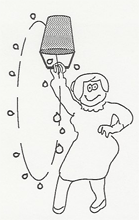Most of us probably remember this experiment from high school physics lessons: you take a bucket on a string filled with water, spin it around your head and the water does not spill. "But how?" - you would ask in amazement. And the teacher would explain then:
"You see, the bucket is spinning, and this creates the so-called centrifugal force acting on the water, which cancels out gravity and thus keeps the water in the bucket". And you will have a hard time finding any other explanation. At least I failed no matter how hard I googled it.
Unfortunately, this explanation looses an essential point of the experiment and I have seen people irreparaply braindamaged by the blind belief that it is only due to rotation and the resulting virtual centrifugal force that the water does not spill.
However, it is not quite the case. Let us imagine that the bucket has accidentally stopped right over your head and as a result, all centrifugal force has been immediately lost. Would the water spill? It will certainly fall down on your head, but it will do so together with the bucket. Thus, technically, the water will stay inside the bucket.
In fact, the proper way to enjoy the true magic of the experiment is not to swing the bucket in full circles, but rather let it swing back and forth as a pendulum (if you have a string and a beverage bottle nearby, you can do an experiment right now). One will then observe that even at the highest points of the swing, where the bottom of the bucket is at its steepest angle and the centrifugal force is nonexistant, the water stays strictly parallel to the bottom of the bucket, as if no gravity would act upon it. Why doesn't it spill? Clearly, the argument of centrifugal force cancelling gravity is inappropriate.
The proper explanation is actually quite simple and much more generic. We have two objects here: the bucket and the water in it. There is one (real) force acting on the water: gravity G. There are two (real) forces acting on the bucket: gravity G and the strain S of the string pulling the bucket perpendicularly to its bottom. (Note that the centrifugal force is not "real" and I do not consider it here, but if you wish, you may. Just remember then that it acts both on the water and the bucket.)
Now the question of interest is, how does water behave with respect to the bucket? That is, what force "pulls" the water towards the bucket and vice-versa. This can be easily computed by subtracting all forces acting on the bucket from all forces acting on the water. And the result is, of course, G - (S+G) = -S, i.e. a force, pulling the water directly towards the bottom of the bucket.
A magical consequence of this argument is that gravity does not matter inside the bucket, as long as it can act on the bucket freely in the same way as on anything inside it. Nothing special about rotation here, really. It takes a while to realize.







